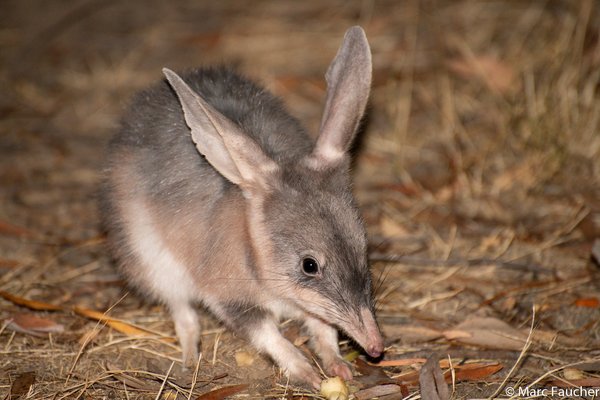The ultimate hide & seek champion: Pygmy blue-tongues can stay hidden in flooded burrows
Did you know that endangered pygmy blue-tongues are champions at holding their breath? These lizards can temporarily suspend their breathing for almost 40 minutes in rain flooded burrows. Kim Michael, recipient of the 2022/23 Peter Rankin Trust Fund for Herpetology, tells us more.
The pygmy blue-tongue (Tiliqua adelaidensis) is the smallest species of blue-tongue – and, it turns out, an ultimate hide and seek champion. Considered extinct since 1959 until 1992, this species of lizard was discovered by chance in the belly of a dead brown snake. So where had they been hiding all this time? Pygmy blue-tongues are able to hide in spider burrows, as small in diameter as a 10 or 20 cent coin in agricultural grasslands, making them tricky to monitor and translocate.

© Kimberley Michael
Monitoring endangered species and understanding how they interact with their environment is essential to their conservation, particularly post-translocation. The pygmy blue-tongue was historically found in Adelaide, however, they are now only found in a 150 km range of mid-north South Australia. Like many species, pygmy blue-tongues are threatened by habitat loss and climate change. The known populations are all isolated due to habitat loss, and the lizards face a predicted extinction due to climate change. Species distribution modelling has shown that by moving the lizards back towards Adelaide, we can aid in their conservation (and hopefully by migrating the species further south, mitigate a second extinction).
PhD candidate and 2022/23 Peter Rankin Trust Fund for Herpetology recipient, Kim Michael, investigated this species' burrow preferences at an experimental translocation site, located on a private sheep farm near Adelaide. This site had a natural spider population (and therefore spider burrows), and the habitat was supplemented by artificial burrows (a hollowed wooden dowel hammered vertically into the ground). Once the pygmy blue-tongues were translocated, Kim and the team discovered a new adaptation.
During the 2022 surveys, there were heavy rainfalls which subsequently flooded both spider and artificial burrows, making it difficult to monitor the lizards. Typically, an endoscope is used by researchers to monitor lizards in these burrows (see images below). This season, the lizards could be seen completely submerged within their burrows but the lizards did not appear to suffer any detrimental effects or attempt to leave a flooded burrow for a dry burrow. Even though the spider burrows appeared to drain more readily than the artificial burrows, the lizards did not prefer either burrow type, despite the artificial burrows remaining waterlogged for the entire week of surveys. Kim and the team investigated burrow availability and whether the lizards could move out of a waterlogged artificial burrow but found that only 3.3% of burrows were available for them to move into.

© Riley Morris

© Kimberley Michael
So, the question remained: how long could a pygmy blue-tongue hold its breath under water? Kim and the team found the longest time submerged was 38:21 minutes, with the average time submerged 28:32 minutes, and they can emerge to the surface for a short breath and then re-submerge themselves.
This adaptation is known as apnoea. It is likely all pygmy blue-tongues can exhibit apnoea as the translocated lizards were founded from wild populations. Although the team found no evidence that pygmy blue-tongues prefer to occupy a spider burrow rather than an artificial burrow, the results could have been impacted by burrow availability. Conservation of the pygmy blue-tongue will require future translocations, and artificial burrows can be used to supplement burrow availability.
Kim’s work now involves assessing habitat suitability to inform future translocation decisions, such as investigating microhabitat preferences to inform best placement of artificial burrows, and other ways to install artificial burrows to prevent flooding by rain.
Kimberley H. Michael, PhD Candidate, College of Science and Engineering, Flinders University; and 2022/23 Peter Rankin Trust Fund for Herpetology recipient, Australian Museum.
Michael G. Gardner, Professor of Biodiversity and Ecology, Flinders University; Honorary of Evolutionary Biology Unit, South Australian Museum.
More information:
Michael, K. H. & Gardner, M. G. (2023). Hold your breath: Observations of the endangered pygmy bluetongue (Tiliqua adelaidensis) submerged in flooded burrows. Austral Ecology. https://doi.org/10.1111/aec.13351
Acknowledgments:
We thank the Koch family for allowing access to the study site. We are grateful to volunteers for their assistance in the field. This research has been supported by Australian Society of Herpetologists, Field Naturalists Society of South Australia, Peter Rankin Trust Fund for Herpetology, Linnean Society of New South Wales, Biology Society of South Australia/Nature Conservation Society of South Australia, and Australian Research Council. The Peter Rankin Trust Fund for Herpetology has specifically aided in habitat suitability assessments of potential translocation sites for the pygmy blue-tongue in Adelaide – and Kim looks forward to writing another blog in the future regarding these results. Kim was also very privileged to meet with herpetologists who knew Peter Rankin personally. Peter Rankin was highly respected and anticipated to be one of the greatest herpetological experts, although Kim does not fill his shoes, she is incredibly grateful for insight into his and associate’s legacies. She urges the community to observe the reptiles around them as you never know what you may find!












